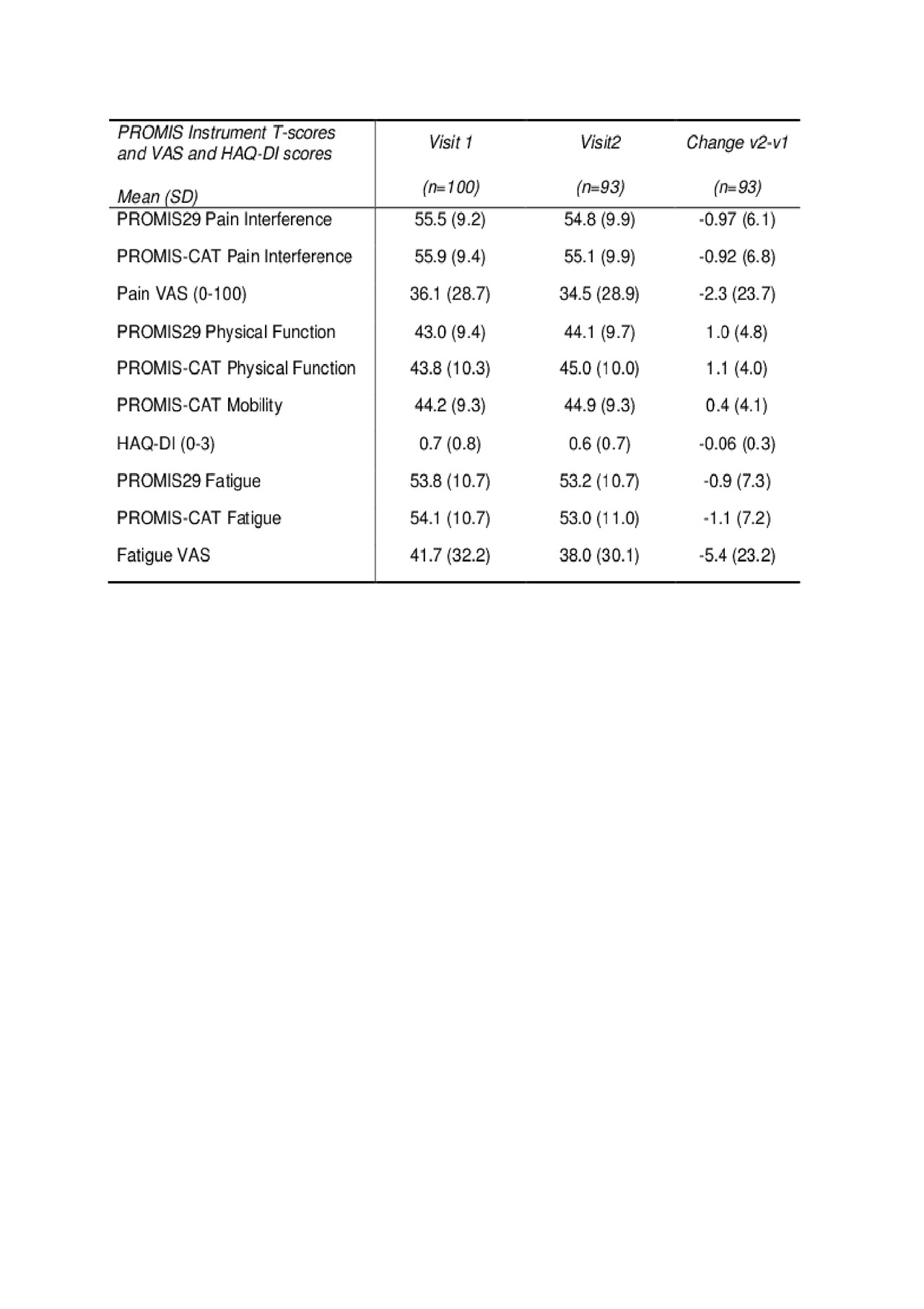Session Information
Session Type: Poster Session (Tuesday)
Session Time: 9:00AM-11:00AM
Background/Purpose: Pain, physical function and fatigue are outcomes reported as having the greatest importance to people with psoriatic arthritis (PsA)1,2. We assessed these outcomes in participants in a longitudinal PsA study using Patient Reported Outcomes Measurement Information System (PROMIS) measures, which have not been used before in PsA, concomitantly with measures of PsA-specific disease activity and patient reported outcomes. The objective was to assess construct validity of PROMIS measures in PsA.
Methods: Participants were followed quarterly in conjunction with rheumatology clinical care visits. Disease activity was assessed using the clinical Disease Activity Score in Psoriatic Arthritis (cDAPSA), Minimal Disease Activity (MDA) state, and their components: 68 tender joint counts, 66 swollen joint counts, Leeds Enthesitis Index (LEI), patient global assessment visual analog scales (VAS) of arthritis/psoriasis and PsA, pain VAS, and Health Assessment Questionnaire Disability Index (HAQ-DI). Pain interference, Physical function/Mobility, and Fatigue PROMIS-Profile29 short forms and computer adaptive test (CAT) were also collected. Spearman correlation coefficients (rho) were computed between PROMIS Pain Interference and Pain Visual Analog Scale (VAS), PROMIS Physical Function/Mobility and HAQ-DI, and PROMIS Fatigue and Fatigue VAS to assess construct validity of point scores (at both visits) and change scores (between the two visits). Approximate 95% confidence intervals for rho were constructed by bootstrapping. We hypothesized moderate to high correlations for point scores ( >0.6) and due to measurement error, low to moderate correlations for change scores ( >0.2).
Results: One hundred participants had a baseline visit and 93 a second study visit, all met CASPAR PsA classification criteria. Mean age (SD) was 52 (12) years, PsA disease duration 17.7 (13) years, 88% were white and 60% female. At baseline, mean (SD) 68 tender and 66 swollen joint counts were 3.2 (4.9) and 3.1 (3.7), 8% had enthesitis, 3% dactylitis; mean(SD) HAQ-DI was 0.7(0.8), PsAID 3.21 (2.4), pain VAS 36 (28.7)mm, and patient global PsA 37.7 (31.7)mm. MDA state was met by 50% and DAPSA treat-to-target by 55%. Participants were treated with biologicals alone or in DMARD combination (44% TNFi, 5% IL17i, 6% IL12/23i), and 45% with DMARD alone. Visit and change PROMIS scores are shown in Table 1 and were higher/worse than the general population (reference T-score of 50) for Pain interference and Fatigue and lower/worse for Physical Function/Mobility. As hypothesized, correlations between point scores of PROMIS and corresponding instruments were high at both visits ( >0.8) and correlation between change scores were low to moderate ( >0.3) (Table 2).
Conclusion: PROMIS Profile29 short forms and corresponding PROMIS CAT Pain interference, Physical Function/Mobility and Fatigue have good construct validity for assessing PsA symptoms and life impact in both cross-sectional and longitudinal analyses. PROMIS measures can be used in psoriatic arthritis clinical care and research.
References: 1. Tillett W, et al. J Rheumatol. 2017 Oct;44(10):1445-1452; 2. Orbai A, et al. Ann Rheum Dis. 2017 Apr;76(4):673-680
To cite this abstract in AMA style:
Orbai A, Perin J, Wu A, Smith K, Bingham C. Static and Longitudinal Construct Validity of PROMIS CAT and Profile29 for Assessing Pain Interference, Physical Function and Fatigue in Psoriatic Arthritis [abstract]. Arthritis Rheumatol. 2019; 71 (suppl 10). https://acrabstracts.org/abstract/static-and-longitudinal-construct-validity-of-promis-cat-and-profile29-for-assessing-pain-interference-physical-function-and-fatigue-in-psoriatic-arthritis/. Accessed .« Back to 2019 ACR/ARP Annual Meeting
ACR Meeting Abstracts - https://acrabstracts.org/abstract/static-and-longitudinal-construct-validity-of-promis-cat-and-profile29-for-assessing-pain-interference-physical-function-and-fatigue-in-psoriatic-arthritis/


